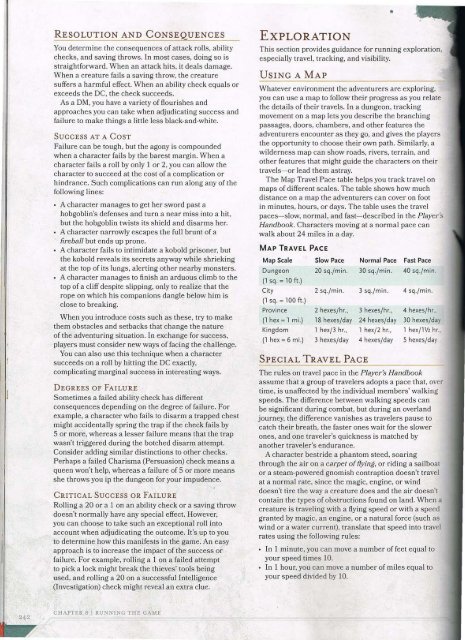Dungeon Master's Guide
Create successful ePaper yourself
Turn your PDF publications into a flip-book with our unique Google optimized e-Paper software.
•<br />
RESOLUTION AND CONSEQUENCES<br />
You determine the consequences of attack rolls, ability<br />
checks, and saving throws. In most cases, doing so is<br />
straightforward. When an attack hits, it deals damage.<br />
When a creature fails a saving throw, the creature<br />
suffers a harmful effect. When an ability check equals or<br />
exceeds the DC, the check succeeds.<br />
As a DM, you have a variety of flourishes and<br />
approaches you can take when adjudicating success and<br />
failure to make things a little less black-and-white.<br />
SuccEss AT A CosT<br />
Failure can be tough, but the agony is compounded<br />
when a character fails by the barest margin. When a<br />
character fails a roll by only 1 or 2, you can allow the<br />
character to succeed at the cost of a complication or<br />
hindrance. Such complications can run along any of the<br />
following lines:<br />
A character manages to get her sword past a<br />
hobgoblin's defenses and turn a near miss into a hit,<br />
but the hobgoblin twists its shield and disarms her.<br />
A character narrowly escapes the full brunt of a<br />
fireball but ends up prone.<br />
A character fails to intimidate a kobold prisoner, but<br />
the kobold reveals its secrets anyway while shrieking<br />
at the top of its lungs, alerting other nearby monsters.<br />
• A character manages to finish an arduous climb to the<br />
top of a cliff despite slipping, only to realize that the<br />
rope on which his companions dangle below him is<br />
close to breaking.<br />
When you introduce costs such as these, try to make<br />
them obstacles and setbacks that change the nature<br />
of the adventuring situation. In exchange for success,<br />
players must consider new ways of facing the challenge.<br />
You can also use this technique when a character<br />
succeeds on a roll by hitting the DC exactly,<br />
complicating marginal success in interesting ways.<br />
DEGREES OF FAILURE<br />
Sometimes a failed ability check has different<br />
consequences depending on the degree of failure. For<br />
example, a character who fails to disarm a trapped chest<br />
might accidentally spring the trap if the check fails by<br />
5 or more, whereas a lesser failure means that the trap<br />
wasn't triggered during the botched disarm attempt.<br />
Consider adding similar distinctions to other checks.<br />
Perhaps a failed Charisma (Persuasion) check means a<br />
queen won't help, whereas a failure of 5 or more means<br />
she throws you ir the dungeon for your impudence.<br />
CRITICAL SUCCESS OR FAILURE<br />
Rolling a 20 or a 1 on an ability check or a saving throw<br />
doesn't normally have any special effect. However,<br />
you can choose to take such an exceptional roll into<br />
account when adjudicating the outcome. It's up to you<br />
to determine how this manifests in the game. An easy<br />
approach is to increase the impact of the success or<br />
failure. For example, rolling a 1 on a failed attempt<br />
to pick a lock might break the thieves' tools being<br />
used, and rolling a 20 on a successful Intelligence<br />
(Investigation) check might reveal an extra clue.<br />
EXPLORATION<br />
This section provides guidance for running exploration,<br />
especially travel, tracking, and visibility.<br />
USING A MAP<br />
Whatever environment the adventurers are exploring,<br />
you can use a map to follow their progress as you relate<br />
the details of their travels. In a dungeon, tracking<br />
movement on a map lets you describe the branching<br />
passages, doors, chambers, and other features the<br />
adventurers encounter as they go, and gives the players<br />
the opportunity to choose their own path. Similarly, a<br />
wilderness map can show roads, rivers, terrain, and<br />
other features that might guide the characters on their<br />
travels- or lead them astray.<br />
The Map Travel Pace table helps you track travel on<br />
maps of different scales. The table shows how much<br />
distance on a map the adventurers can cover on foot<br />
in minutes, hours, or days. The table uses the travel<br />
paces- slow, normal, and fast-described in the Player's<br />
Handbook. Characters moving at a normal pace can<br />
walk about 24 miles in a day.<br />
MAP TRAVEL PACE<br />
Map Scale Slow Pace Normal Pace Fast Pace<br />
<strong>Dungeon</strong> 20 sq.fmin. 30 sq.fmin. 40 sq.fmin.<br />
(1 sq.= 10ft.)<br />
City 2 sq.fm in. 3 sq.fmin. 4 sq.fmin.<br />
(1 sq.= 100ft.)<br />
Province 2 hexesjhr., 3 hexesfhr., 4 hexesjhr.,<br />
(1 hex= 1 mi.) 18 hexesfday 24 hexesfday 30 hexesjday<br />
Kingdom 1 hexf3 hr., 1 hexf2 hr., 1 hexjll/2 hr.,<br />
(1 hex= 6 mi .) 3 hexesjday 4 hexesfday 5 hexesjday<br />
SPECIAL TRAVEL PACE<br />
The rules ori travel pace in the Player's Handbook<br />
assume that a group of travelers adopts a pace that, over<br />
time, is unaffected by the individual members' walking<br />
speeds. The difference between walking speeds can<br />
be significant during combat, but during an overland<br />
journey, the difference vanishes as travelers pause to<br />
catch their breath, the faster ones wait for the slower<br />
ones, and one traveler's quickness is matched by<br />
another traveler's endurance.<br />
A character bestride a phantom steed, soaring<br />
through the air on a carpet of flying, or riding a sailboar<br />
or a steam-powered gnomish contraption doesn't travel<br />
at a normal rate, since the magic, engine, or wind<br />
doesn't tire the way a creature does and the air doesn't<br />
contain the types of obstructions found on land. When a<br />
creature is traveling with a flying speed or with a speed<br />
granted by magic, an engine, or a natural force (such as<br />
wind or a water current), translate that speed into travel<br />
rates using the following rules:<br />
In 1 minute, you can move a number of feet equal to<br />
your speed times 10.<br />
In 1 hour, you can move a number of miles equal to<br />
your speed divided by 10.<br />
CHAPTER 8 I RUNNING THE GAME




